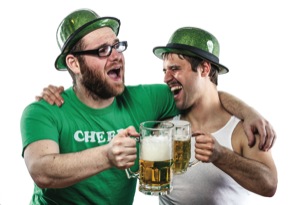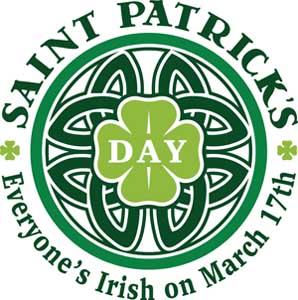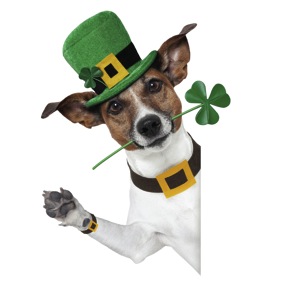
As unofficial national holidays go, St. Patrick’s Day holds a unique position on the Western calendar. It’s one of the oldest celebrations our country has known, aside from Christmas and Independence Day, and it’s one of the few days of the year that Americans allow themselves to get blindingly drunk in so public a fashion.
But it’s also a solemn occasion, too, when Catholics, Christians and Lutherans among others give thanks the world over to one of their patron saints and the arrival of Christianity to Ireland.
The shamrock, the famous three-leaved plant, has a particular resonance. For many Irish-Catholics it’s a symbol, a critical link to the long-ago, then-heavily-populated pagan Northern Ireland which St. Patrick successfully used to explain the Holy Trinity to the masses. According to legend he spent many years evangelizing in the northern half of Ireland and converted “thousands”.
For all the unease St. Patrick’s Day has caused in the LGBTQ community, it isn’t Catholic in origin nor is it particularly religious, two areas where gays have hit some of their hardest speed bumps in the race to full equality. It was actually Protestants as early as 1737 who gathered to toast their homeland and it was a mostly staid affair, hardly the source of religiosity and controversy to come.
Fast forward almost 60 years, with the birth pangs of the Second Great American Spiritual Awakening upon us, and you now find, in tempo with the times, a day of service and a special dinner being cast in stone as the tradition for years to come. But parades celebrating Irish culture and contributions date back to the early 1760s in New York. (The parade as we have come to know it didn’t really come into being until the early 20th century when Macy’s – yes, Macy’s – launched what would become the annual Macy’s Thanksgiving Day Parade in 1924.)
San Diegans began celebrating St. Patrick’s Day annually in the form of a parade in 1981 putting it in the bottom five of American cities that have subsequently held annual parades. (What they lack in history, many argue, San Diegans more than make up for in zeal, given the extent and degree with which so many of us celebrate.)
We’re Irish first, LGBTQ second
The case that is remembered most famously for challenging the St. Patrick’s Day parade ban on openly LGBT members marching is Hurley v. Irish American Gay, Lesbian, and Bisexual Group of Boston (LGIB) U.S. 557 (1995). But while open participation ended there unfavorably for the LGBTQ community for some time to come, it certainly didn’t start there. LGIB had been challenging the Boston City Council (which issues licenses, provides public accommodations, etc.) for almost four years previously.
For the South Boston Veteran Allied War Council, the pre-eminent participatory group, the matter was simple: The parade was a celebration of Irish culture and any group or groups that desired to participate in the parade must convey that message and only that message. For LGIB, the argument was seen the same way. They were a small band of proud Irish-Americans who just happened to be gay, lesbian, bisexual or transgender and deserved to be allowed to participate.

But year after arduous year the LGIB were required to re-apply to participate under circumstances without precedent. There were lawsuits and court battles and backroom negotiations with then-Mayor Ray Flynn and compromises on the size and behavior of gay participants. But the LGIB won on the strength of their argument that the St. Patrick’s Day parade was a public event held in public accommodations. And in that first year of victory, 1992, the Boston Globe reported on their historic inclusion as such: “[A] 5-mile gauntlet of hostility that sometimes threatened to erupt into wide-scale violence where the [LGIB] marchers faced an outpouring of vituperation that spanned generational lines.” The Globe added that several smoke bombs were tossed into their midst. In an editorial the paper concluded that “despite Sunday’s epithets and excesses, the parade went off relatively well.”
June 19, 1995
The ongoing battles continued until the case made its way before the U.S. Supreme Court. Known officially as John J. Hurley and South Boston Allied War Veterans Council v. Irish-American Gay, Lesbian and Bisexual Group of Boston, Etc., the court issued its unanimous decision on a Monday. Speaking for the court, associate justice David Souter declared: “Private citizens organizing a public demonstration may not be compelled by the state to include groups who impart a message the organizers do not want to be included in their demonstration.”
Fifteen months later, almost to the day, the U.S Congress passed and then-President Bill Clinton signed into law the Defense of Marriage act or DOMA. To the LGBT community, progress seemed as elusive as ever.
Fast forward two decades later
In 2014, despite a louder call to justify banning the groups, the grousing and disassembling from Irish-American veterans grew more entrenched and members of the Irish-American LGBTQ communities were still banned from marching in both the Boston and New York St. Patrick’s Day parades.
But a new political reality existed. One where major sponsors like Guinness and Sam Adams pulled ads and money from cities that continued to bar LGBT groups from participating; namely New York and Boston. Missing, too, would be the mayors of those two cities. Last year, both Bill de Blasio and Marty Walsh were nowhere to be found the day of the parade. (This year, both Boston and New York are allowing LGBTQ groups to participate but for different reasons. Boston has concluded that they’re veterans first and something else second. But in New York, the LGBTQ community has been allowed to march for some time sans the banner. This year, they will have their banner.
We’re all Irish-Americans now
So now, if you’re gay or if you’re not, when you’re slurping down that fifth drink while celebrating St. Patrick – but drunkenly calling it St. Thackwhich – at least you’ll know how much bullshit we have to go through first before we can sit down among friends and strangers alike and get totally sideswiped together regardless of politics or sexual orientation.

Happenings:
Be sure to mark March 14 on your calendar. It’s the Holy Day of St. Patrickness in San Diego. There’s the parade, of course, that starts on Fifth Avenue at Laurel Street at 10:30 a.m. (and bills itself as the largest parade of its kind west of the Mississippi). It winds its way around until you end up in a beer garden among choice locales. Then, the Gaslamp becomes one big bowl of green pea soup with green streets, green beer and more than one’s share of green vomit. The giant Shamrock Gaslamp festival starts at 4 p.m. and runs until midnight.
Locally, the LGBT community will be also be getting into the spirit. Mo’s and a list of other gay bars promise green beer and good times with drink specials, dancing and, perhaps, for some single people looking, a bit of the famed Irish luck.












The Irish LGBT community groups are not allowed to march in this years NYC St Patricks Day Parade. NBC-A corporate sponsor broadcasting the parade are allowing some members of staff who are gay to march. They are not allowed to march behind a banner identifying themselves as LGBT.
Your reporting is incorrect about NY. Maybe check in with some of the grassroots organizing that has be ongoing for 24 years-like with Irish Qeers-NYC?????.
You are absolutely incorrect. According to the New York Times, “This year, the Manhattan parade will include a delegation of NBCUniversal employees walking under a lesbian, gay, bisexual and transgender banner.”
While you may personally feel this is not “gay enough,” the story is accurate. This is the first time an LGBT group is being allowed to March in the New York City St. Patrick’s Day parade under a banner.